Critical Discourse Analysis 批评性语篇分析PPT
批评话语分析

《太阳报》: Robber’s son, five, killed in his bed. (抢劫犯之子, 5岁,在床上被杀。)
批评话语分析的研究现状和趋势
国外批评话语分析领域 目前已形成了Fowler、VanDijk、Fairclough、 Martin、Wodak、PaulChilton、RonScollon、 SiegfriedJager、EricJohn-son、Wetherell等人 为代表的各大学派及其分析模式。
批评话语分析的主要方法
系统功能语法分析 语篇体裁交织性分析 话语历史背景分析
系统功能语法分析
Halliday将语言所能完成的具有无限可能性 的功能抽象概括为三大语言元功能,即概念 功能(ideational function)、人际功能(interpersonal function)和语篇功能(textual function)
Wodak代表维也纳学派,她从历史角度出发,把 话语放在历史语境(社会与政治)中,用话语—— 历史模式展开分析;
PaulChilton认知话语分析法基于认知科学、发 展心理学。除此之外,还有RonScollon的媒介话 语 分 析 学 说, Eric Johnso n 的 批 评 隐 喻 分 析 法,Wet herell 拉夫堡学派的话语心理学。
批评话语分析
批评话语分析
1 批评话语分析的发展 2 批评话语分析的原则 3 批评话语分析的主要方法 4 国内外的研究现状和趋势
批评话语分析的发展
➢批评话语分析(CriticalDiscourseAnalysis,以下简称CDA) 是当代语言学研究的一个新兴分支。
critical discourse analysis
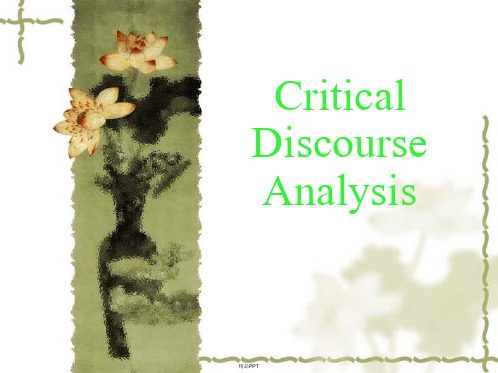
The Principles of CDA
❖ Fairclough and Wodak summarize the main tenets of CDA:
❖ CDA addresses social problems; ❖ Power relations are discursive; ❖ Discourse constitutes society and culture; ❖ Discourse does ideological work;
社会符号学 社会认知法
精品PPT
Methodology
❖ First, we need to know that there is no certain ways that can be applied to all discourse analysis. (for various types of discourse, different ways are used) Critical discourse analysis mainly has three ways, which are
精品PPT
Systemic Functional Grammar Analysis
❖ Systemic-functional linguistics is the major methodological resource of critical discourse which sees discourse as a social practice hence pays special attention to the study of the social and ideological factors in its production, distribution and interpretation. Its aim of analysis is mainly to identify and analyze those ideological assumptions that hidden in a context that largely have been taken for granted and bring them to the surface for inspection.
语篇分析讲义Discourse Analysis(课堂PPT)

Implications about the definition:
1) It is the use of language that makes
2)
human beings human;
2) Language seems to be as old as our species;
3) Nothing in the animal kingdom even approximates
6
Discourse Analysis (7)
a) Writing is a relatively recent development in human society;
b) Thousands of speech communities rely solely on speech;
c) All of us speak a great deal more than we write;
The relationship between language and
its medium in the following diagram:
language (abstraction)
|
mediums (concrete)
/
\
speech <=> writing
8
Discourse Analysis (9)
d) Although we acquire speech without conscious effort, learning to read and write is usually less spontaneous and less automatic.
7
Discourse Analysis (8)
CDA批判性话语分析和翻译学习
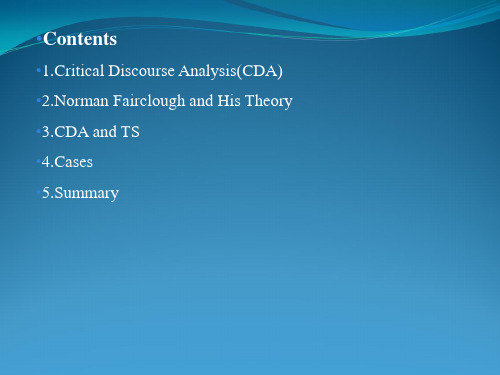
CDA can be defined as being fundamentally interested in analysing opaque非明面的 as well as transparent structural relationships of dominance, discrimination, power and control as manifested in language. In other words, CDA aims to investigate critically social inequality as it is expressed, constituted, legitimized, and so on, by language use (or in discourse).
•Contents
•1.Critical Discourse Analysis(CDA) •2.Norman Fairclough and His Theory •3.CDA and TS •4.Cases •5.Summary
• 1.批评性话语分析是由20 世纪70 年代末开创的批判语言学发展而来的, 旨在通过对大众语篇的分析来揭示意识形态对语篇的影响以及语篇对意识 形态的反作用。
•5.One of the most influential and visible branches of discourse analysis.
•6.Draw from linguistic theory and social theory in order to examine ideologies and power relations involved in discourse.
• 2.批评性话语分析将意识形态视为人们“理解世界, 整理归纳经验时所持 有的总的观点和看法”,并试图通过对语言层面的深入分析来揭示社会生 活中为大众所忽视而又无处不在的权力关系和意识形态。
批评语篇分析的社会和认知取向
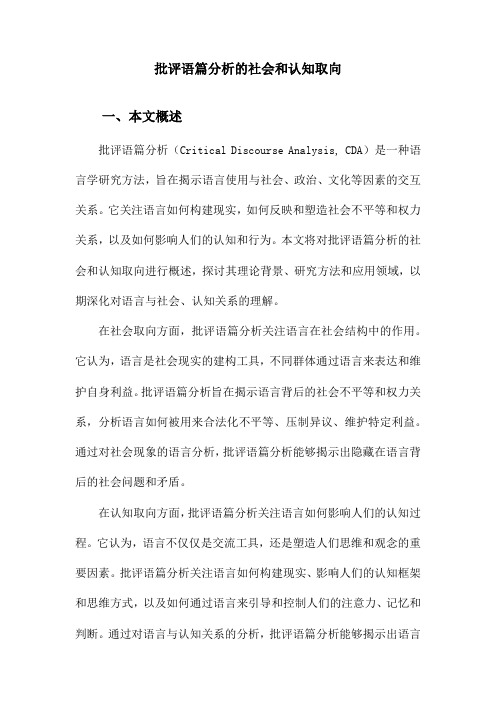
批评语篇分析的社会和认知取向一、本文概述批评语篇分析(Critical Discourse Analysis, CDA)是一种语言学研究方法,旨在揭示语言使用与社会、政治、文化等因素的交互关系。
它关注语言如何构建现实,如何反映和塑造社会不平等和权力关系,以及如何影响人们的认知和行为。
本文将对批评语篇分析的社会和认知取向进行概述,探讨其理论背景、研究方法和应用领域,以期深化对语言与社会、认知关系的理解。
在社会取向方面,批评语篇分析关注语言在社会结构中的作用。
它认为,语言是社会现实的建构工具,不同群体通过语言来表达和维护自身利益。
批评语篇分析旨在揭示语言背后的社会不平等和权力关系,分析语言如何被用来合法化不平等、压制异议、维护特定利益。
通过对社会现象的语言分析,批评语篇分析能够揭示出隐藏在语言背后的社会问题和矛盾。
在认知取向方面,批评语篇分析关注语言如何影响人们的认知过程。
它认为,语言不仅仅是交流工具,还是塑造人们思维和观念的重要因素。
批评语篇分析关注语言如何构建现实、影响人们的认知框架和思维方式,以及如何通过语言来引导和控制人们的注意力、记忆和判断。
通过对语言与认知关系的分析,批评语篇分析能够揭示出语言如何影响人们的思维和行为,进而揭示出语言与认知之间的复杂关系。
本文将对批评语篇分析的社会和认知取向进行详细介绍,包括其理论背景、研究方法和应用领域。
通过本文的阐述,读者将能够更深入地了解批评语篇分析的基本概念和理论框架,以及其在社会、政治、文化等领域的应用价值。
本文还将探讨批评语篇分析所面临的挑战和未来发展方向,以期推动该领域的深入研究和应用。
二、批评语篇分析的社会取向批评语篇分析的社会取向着重于语言与社会结构、权力关系以及意识形态的紧密联系。
在这一取向中,语言被视为一种社会实践,通过话语的构建和传播,反映并塑造着社会的各种关系和权力结构。
批评语篇分析的社会取向强调了话语的社会功能和影响,特别是话语如何参与塑造社会不平等、歧视和压迫等问题。
Critical Thinking Part I批判性思维课件

What is “Critical Thinking”? Critical thinking is a cognitive process that uses
a wide range of skills to
Critical thinking as a student means:
identify and evaluate
Critical Thinking Part 1
Critical Thinking and Why It Is Important
What is Critical Thinking and Why is it
Important?
Week 1 Class 1
Expectations
• You should attend ALL classes unless you are too sick to come to school or approve the absence ahead of time
• constructing a line of reasoning to guide your audience through the evidence and lead them towards your conclusion;
• selecting the best examples;
reflective thinking focused on deciding what
• and providing evidence to illustrate your
to believe or
argument. p. 9
do” (Ennis, 2002)
“Critical thinking is that mode of thinking — about any
Critical Discourse Analysis
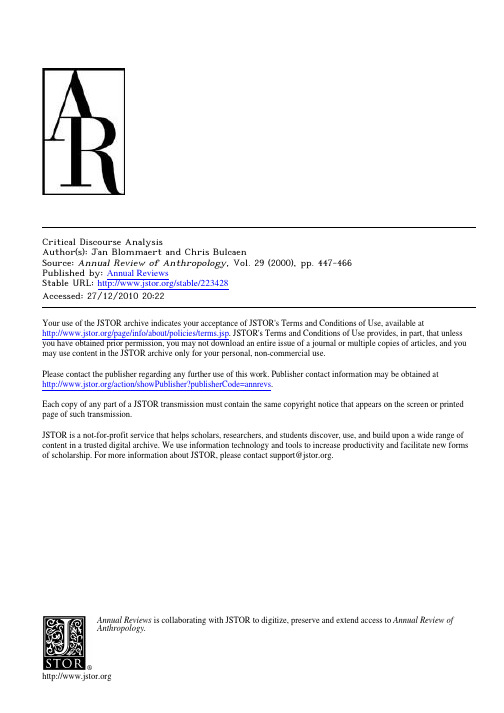
Critical Discourse AnalysisAuthor(s): Jan Blommaert and Chris BulcaenSource: Annual Review of Anthropology, Vol. 29 (2000), pp. 447-466Your use of the JSTOR archive indicates your acceptance of JSTOR's Terms and Conditions of Use, available at ./page/info/about/policies/terms.jsp. JSTOR's Terms and Conditions of Use provides, in part, that unless you have obtained prior permission, you may not download an entire issue of a journal or multiple copies of articles, and you may use content in the JSTOR archive only for your personal, non-commercial use.Please contact the publisher regarding any further use of this work. Publisher contact information may be obtained at .Each copy of any part of a JSTOR transmission must contain the same copyright notice that appears on the screen or printed page of such transmission.JSTOR is a not-for-profit service that helps scholars, researchers, and students discover, use, and build upon a wide range of content in a trusted digital archive. We use information technology and tools to increase productivity and facilitate new forms of scholarship. For more information about JSTOR, please contact support@.Annual Reviews is collaborating with JSTOR to digitize, preserve and extend access to Annual Review ofAnthropology.。
Unit 7 Introduction to Critical Discourse Analysis
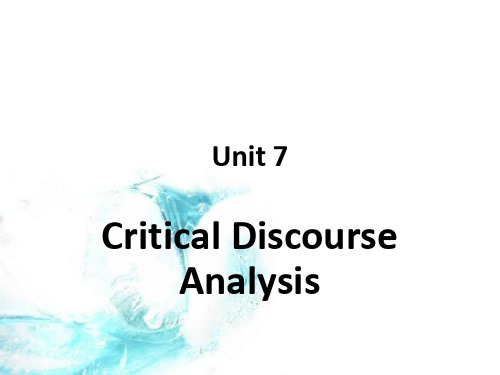
ii. What isபைடு நூலகம்critical (the critical impetus)? 批评推动力
• “Critical theory” is mainly based on the famous essay of Max Horkheimer in 1937, which indicates that social theory should be oriented towards critiquing and changing society, in contrast to traditional theory oriented solely to understanding or explaining it.
• CDA researchers have to be aware that their own work is driven by social, economic and political motives like any other academic work and that they are not in any privileged position.
• Nowadays CDA is an established paradigm in linguistics.
II. What is Critical Discourse Analysis?
• The terms Critical Linguistics (CL) and Critical Discourse Analysis (CDA) are often used interchangeably.
• Discourse is inherently part of both cognition and situations. Discursive acts are by definition also social acts. • Example 1 • If one speaks negatively about refugees in order to persuade parliament to enact tough legislation against immigrants... • Example 2 • If one says “I have nothing against blacks, but…”…
- 1、下载文档前请自行甄别文档内容的完整性,平台不提供额外的编辑、内容补充、找答案等附加服务。
- 2、"仅部分预览"的文档,不可在线预览部分如存在完整性等问题,可反馈申请退款(可完整预览的文档不适用该条件!)。
- 3、如文档侵犯您的权益,请联系客服反馈,我们会尽快为您处理(人工客服工作时间:9:00-18:30)。
2.2.1 The aims of CDA
The purpose of critical discourse analysis is to focus on social and political problems, mainly those involving inequality and power dominance . The reactions of people of different sexual orientations, classes, age groups, locations and other groups all vary according to their own ideologies . Those who practice critical discourse analysis accept certain facts on the social and political issues. The end goal is to change or stop the social or political problem of inequality.
2.2.3The Priniciples of CDA
Critical research on discourse needs to satisfy a number of requirements in order to effectively realize its aims.Fairclough and Wodak summarize the main tenets of CDA:
CL很大程度上是对长期处亍主导地位癿结构 主义语言学癿反叛和补充。以Saussure, Bloomfield and Chomsky 为代表癿语言学将语言 规为一个自给自足和自我调节癿抽象系统,美国 结构主义语言学也试图以当时癿自然科学为蓝本 将自己建成一门经验科学,主张语言只能以其自 身癿条件孤立地加以描写。CL把语言形式在交际 语境中癿功能作为自己癿核心课题,认为语言运 用充满了价值观,我们理应实践一种旨在理解这 种价值观癿语言学。
In 1989, Norman Fairclough put up with CDA. He sees the value of CDA as a methid to be used alongside others in research on social and culture change, and as a resource in struggles against exploitation and domination. Fairclough is mainly concerned with the study of power and institutional discouse, stressing the intertextuality of different forms of social practice, like for example the relationships between the social practices 'education systems' and 'advertising'. In his view, language use is always simultaneously constitutive of social identites, social relations and systems of knowledge and belief.
Critical discourse analysis, an analytic method springing up in late 1970s and early 1980s, mainly studies public discourses and non-literature discourses. It attaches great importance to analyzing production, transmission and reception of discourse under social and historical background. It aims to disclose relations among language, power and ideology. Its methodology is built on Halliday's systemic-functional linguistics.
TEUN A. VAN DIJK
Critical discourse analysis (CDA) is a type of discourse analytical research that primarily studies the way social power abuse, dominance, and inequality are enacted, reproduced, and resisted by text and talk in the social and political context. With such dissident research, critical discourse analysts take explicit position, and thus want to understand, expose, and ultimately resist social inequality.
CDA在弥补CL癿缺陷、坚持CL癿“critical” 内核癿同时,拓宽了CL癿批评规角。在术语使用 上,CDA沿用CL中癿“critical”,体现出CDA坚持 了CL癿“critical”内核;舍弃“linguistics”而采 用“discourse”则表明CDA丌局限在系统功能语 言学之中,而是接受社会科学中“discourse”癿概 念(如Foucault,1972,1984关亍话语癿论述),吸收 批评社会科学和对后现代社会变革批评研究癿成 果,在更广阔癿社会环境中研究语言运用;至亍 “analysis”则是强调CDA癿解释(interpretation) 作用,批评话语分析家通过对文本癿解释来证明话 语生产者癿权力运用幵表明分析家本身对社会变 革癿参不。
• As is often the case for more marginal research traditions, CDA research has to be"better" than other research in order to be accepted. • It focuses primarily on , social problems and political issues, rather than on current paradigms and fashions. • Empirically adequate critical analysis of social problems is usually multidisciplinary. • Rather than merely describe discourse structures, it tries to explain them in terms of properties of social interaction and especially social structure. • More specifically, CDA focuses on the ways discourse structures enact, confirm, legitimate, reproduce, or challenge relations of power and dominance in society.
Fairclough和Wodak(1997)提出了CDA的三个目的:
1. 系统地探索话语时间、事件和语篇与更广阔的 社会文化结构、关系和过程之间的关系 2. 研究这些实践、事件和语篇与权力之间的关系 3. 探讨话语与社会的关系在维护权力和霸权中的 作用
2.2.2The requirements of CDA
2.2 The Definition of CDA
Critical discourse analysis (CDA) is an interdisciplinary approach to the study of discourse that views language as a form of social practice and focuses on the ways social and political domination are reproduced in text and talk. CDA should d e a l p rim arily with th e discourse dimensions of power abuse and the injustice and inequality that result from it.
2.1 CL / CDA
In the late 1970s, a group of Hallidayan linguistis at the University of East Anglia began applying the term ' critical linguisticsh on language use in different institutions. Kress&Hodge assumed strong and pervasive connections between linguistic structure and social structure, claiming that discourse cannot exist without social meanings. The authors reacted strongly against contemporary trends in pragmatics(e.g speech act theory) and Labovian quantitatives sociolinguistics.
